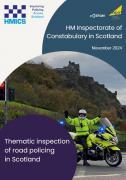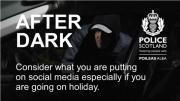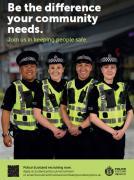Road Safety Advice - Winter Conditions
17th November 2012
Below are some important tips being offered by Police.
During the winter months, road conditions can be extremely difficult and dangerous. Motorists need to pay extra attention and be prepared to adapt to changing conditions. Even the most experienced motorists can find themselves getting into difficulties when the roads are icy. Our advice is to consider if your journey is absolutely necessary and if you must drive then ensure that you and your car are adequately prepared for the journey ahead.
Before you set off on your journey:
It is vitally important to make sure your vehicle is adequately maintained and that brakes, tyres, lights, batteries, windscreens and wiper blades are in good condition.
Tyres are the only point of contact with the road and if they are worn or incorrectly inflated then they have less grip and can significantly increase stopping distances in the event of an emergency.
Tyres should also be checked for bulges, cuts or tears which will weaken the tyre and potentially lead to a collision. The minimum legal tread depth is 1.6mm but this is the legal minimum and it must be remembered that tyres perform more efficiently with a greater depth of tread. The recommended depth is 3mm.
Windows including the windscreen should be demisted and fully cleared of any frost, snow or ice.
Check that wiper blades are not worn and are capable of clearing the screen correctly.
Check brakes, lights, oil and washer fluid levels (add winter screen wash to your washer bottle to stop the water from freezing)
Carry water and de-icer in the car with you.
Carry a few essentials in the car at all times, a warm winter jacket preferably a High Visibility one could be a life saver, other items to consider are a torch, first aid box, a blanket, sturdy boots or Wellingtons and even some warm clothes.
If you must travel in wintry weather remember to:
Slow down and leave plenty of room to stop. You should allow at least three times more space than usual between you and the car in front.
Brake gently to avoid skidding. If your wheels lock, ease off the brakes.
Turn on your lights to increase your visibility to other motorists and always clear all ice and snow off the car windows before setting out.
Drive slowly on snow in the highest gear possible.
Do not assume your vehicle can handle all conditions. Even four-wheel drive vehicles can encounter trouble on winter roads.
Visibility is often reduced because of fog, rain, spray, hail or snow.
Remember to ensure that you use dipped headlights in periods of reduced visibility. Fog lights can only be used when visibility is seriously reduced to less than 100 metres but must be switched off if visibility improves.
If you get stuck in snow:
Do not spin your wheels. This will only dig you in deeper. Turn your wheels from side to side a few times to push snow out of the way.
Use a light touch on the accelerator to ease your car out.
Use a shovel to clear snow away from the wheels and the underside of the car.
Pour sand, gravel or salt in the path of the wheels - or even use your floor mats - to help get traction.
If you must leave your car, arrange to have it recovered as soon as possible. If you think it is in a place that may pose a danger to other road users, call the police to let them know.
Pedestrians, Joggers, Cyclists:
Cyclists should ensure that they have suitable lights on their bicycles and that they wear reflective and fluorescent clothing and a cycle helmet.
Pedestrians and Joggers should where possible wear High Visibility clothing or brightly coloured clothing, this will allow other road users to see you earlier.
Everyone using our roads should avoid any distraction devices and that includes using mobile phones and listening to excessively load music through ear phones.
Further advice for joggers can be found on the Jog Scotland website.
Children should also wear brightly coloured or reflective clothing as they will generally be walking to school during darkness or reduced visibility.
Related Businesses
Related Articles
Police - Area Performance Report to Caithness Area Committee on 11 November
A report by the police to the Caithness area committee on 11 November will allow councillors to discuss a range of issues. Chief Inspector Calum Smith - Area Commander (North Highland Area Command) sets out the crime related figures up to June 2024.Police Scotland Urged To Review Its Commitment To Road Policing
A reduction in police activity targeting the most common causes of fatal crashes has been identified as a key factor affecting Police Scotland's ability to keep people safe on the nation's roads. A new report by His Majesty's Inspectorate of Constabulary in Scotland notes that since 2020 the total number of people killed or injured on Scotland’s roads has increased each year.
A836 In Caithness - Average Speed Cameras Go Live Today Monday 2nd September
Police Scotland's North Safety Camera Unit are now operating average speed cameras on the A836 between Reay and Thurso with offences being progressed from Monday 2nd September. In partnership with the Scottish Safety Camera Programme and the Highland Council, the location was identified as having speed concerns and increased traffic volumes, both of which are potential ongoing road safety challenges.
Visiting relatives and friends this Christmas? Make sure your home is safe AFTER DARK
Consider carefully what you are putting on social media, especially if you are staying away to visit friends and relatives this Christmas. Be wary of posting photographs of Christmas parties that contain images of high value jewellery.
POLICE OFFICER RECRUITMENT - CAITHNESS AREA
Would you like to join the Police? Would you like to live and work in the Caithness area? Police Scotland is actively recruiting good quality and eligible candidates specifically for the Caithness area. We are taking applications now for Police Constable / Special Constable Entry for future intakes during 2023/2024.
£74m Police Budget Cut Will Make Communities Less Safe
UNISON, the union for police staff, says Scotland's police budget cut will see even more crime going unreported and crimes not being fully investigated. The union says around 230 police staff could be cut, including fingerprint examiners, forensic examiners, 999 call handlers, custody staff, high-speed driving instructors, cybercrime experts, payroll, HR and IT staff.New Police Commander For Highland And Islands Division Takes Oath
The new Highland and Islands divisional commander will take up post having been sworn in as a Police Scotland officer. Chief Constable Sir Iain Livingstone welcomed and thanked Chief Superintendent Rob Shepherd during a ceremony at Police Scotland Headquarters, Tulliallan, on Monday, 16 January 2023, overseen by Justice of the Peace Gillian Thomson.
Police Complaints, Investigations And Misconduct To Continue After Resignations
Gross misconduct proceedings against police officers should be allowed to continue after they resign from the force to promote transparency and maintain public confidence, according to a public consultation. The move, which would see proceedings continue even if an officer leaves during the course of an investigation into their conduct, was among the recommendations of Dame Elish Angiolini's independent review into how police complaints and allegations of misconduct should be handled.Criminal Proceedings In Scotland 2020-21
The total number of people proceeded against in Scottish courts fell by 46% to 46,497 in the year to 2020-21, according to National Statistics published by Scotland's Chief Statistician today. The number of people convicted fell at a similar rate, down 44% to 42,532.15 Further Call Handling Jobs For Police Centre In Inverness
Cllr Matthew Reiss, Highland Council's Strategic Lead for Police and Fire has welcomed Police Scotland's announcement that it has created fifteen new posts to further enhance the development of call handling services, based in Inverness. He said: "We were delighted in October last year to welcome 25 new jobs in Inverness with the creation of a specialist call handling service team and these fifteen additional new posts based in the Highlands are great news.
